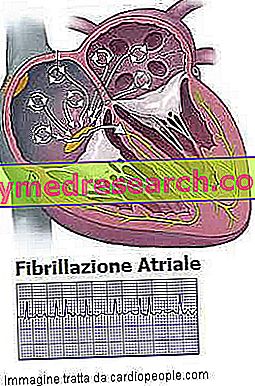Introduction
Like heart attacks, celiac disease can also occur with a procession of abnormal symptoms, which deviates from the normal symptoms. These symptoms are therefore defined as atypical or non-specific .

Knowing how to recognize these symptoms is very important to assess the presence of the disease even in the absence of classic gastrointestinal disorders.
Typical symptoms of celiac disease
The classic symptoms of celiac disease occur at the gastro-intestinal level, sustained by the lesions of the enteric mucosa caused by the autoimmune reaction against the gluten ingested by the diet.
These typical symptoms include:
- intermittent or chronic diarrhea;
- abdominal swelling and distension;
- colitis;
- flatulence;
- abdominal cramps.
As for extra-intestinal manifestations, they are generally included in the list of typical symptoms of celiac disease:
- weakness;
- weight loss;
- anemia and pallor;
- dermatitis herpetiformis.
Typical symptoms in children
Celiac disease can occur at any age, but prevails in children under three years of age, where it produces symptoms such as:
- chronic or recurrent diarrhea, with liquid or semi-liquid stools, clear and smelly;
- digestive difficulties, with nausea and vomiting;
- weight loss or growth deficit;
- swollen belly;
- hypotrophy and muscle weakness;
- lethargy;
- lack of appetite;
- dehydration and electrolyte disturbances;
- behavioral alterations (irritability).
The incidence of celiac disease has long been underestimated precisely because of its tendency to present itself often in the absence of typical symptoms and signs, or to remain silent for a long time.
Today we know that the atypical forms of celiac disease are much more common than the classic ones. For this reason, it is considered that celiac disease can affect up to 1% of the adult population.
Atypical symptoms of celiac disease
Celiac disease tends to manifest itself in a rather heterogeneous way, in the sense that there can be profound differences in the symptoms related to the disease between one celiac individual and another.
In fact, the typical forms represent only the tip of an iceberg, whose submerged part (which represents most of the cases) consists of atypical or silent forms (the forms are considered silent with an absent symptomatology, even in the presence of the typical lesions of the intestinal mucosa).
To be precise, rather than atypical symptoms it would be more correct to speak of atypical signs of celiac disease and, even better, of potentially associated pathologies (and related complications).
The following list of atypical manifestations may appear surprising due to the quantity and heterogeneity of the disorders / diseases potentially attributable to celiac disease. In this regard it is essential to point out that the celiac etiology is precisely a POSSIBILITY, often remote with respect to causes far more common than these disorders / diseases. For this reason, it is essential to avoid self-diagnosis and the spontaneous adoption of a gluten-free diet.
If the reader suspects that he is celiac, or considers it useful to undergo an examination for the diagnosis of celiac disease, he will therefore have to discuss it beforehand with his own doctor.
Atypical symptoms in the intestine
They are considered atypical, more tenuous and nuanced intestinal manifestations than the classic framework described in the previous chapter.
In particular, atypical symptoms very often coincide with those of irritable bowel syndrome, with swelling, abdominal discomfort, flatulence or impaired defecation.
Atypical symptoms at the oral level
- recurrent aphthous stomatitis;
- hypoplasia of tooth enamel;
- atrophic glossitis;
- intraoral manifestations of dermatitis herpetiformis.
Atypical symptoms specific to the female sex
- difficulty in conception;
- recurrent abortions;
- endometriosis;
- late menarche;
- early menopause;
- changes in the menstrual cycle;
- amenorrhea.
Atypical symptoms specific to the male sex
- Low libido;
- Impotence;
- Hypogonadism;
- Oligospermia.
Other atypical symptoms of the disease
- Pubertal delay;
- Hypo / hyperthyroidism;
- arthritis, arthralgia (joint pain);
- Anxiety, depression;
- Osteopenia, osteoporosis;
- Alopecia areata;
- Psoriasis;
- Follicular keratosis;
- Vitiligo;
- Constantly high transaminase values;
- Epilepsy;
- Cerebellar ataxia;
- Bronchial hyperactivity;
- Asthma;
- Spinocerebellar syndrome;
- Peripheral polyneuropathy;
- Asthenia;
- Schizophrenia;
- Dementia;
- Cognitive disorders;
- Hepatic steatosis;
- Hyposplenism (thrombocytosis).
Due to the various atypical manifestations described, celiac disease has earned the nickname "chameleon" disease.



